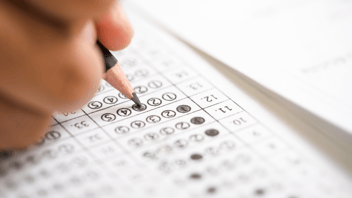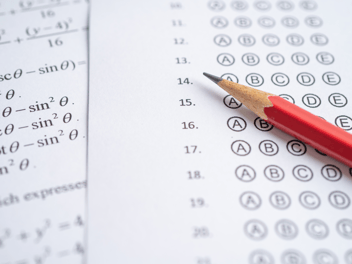

Published: September 07, 2022
Teachers possess the ability to interpret student work and determine their mastery against learning standards. But constantly determining student performance is easier said than done. To effectively measure student progress, teachers need to examine day-to-day student work and year-long growth. That means diving into data large and small—on test scores, student grades, assignment completion rates, and so much more.
When teachers are forced to examine this data manually, it can quickly lead to burnout. Entering each assignment and course grade individually is tedious and time-consuming. As we all know, you have plenty on your plate already. Fortunately, advancements in made-for-school technologies make it easier than ever to measure, manage and evaluate your student performance data.
Let's take a look at how you can use data management tools to assess achievement and optimize instruction for better learning outcomes.
Using EdTech Tools to Measure Student Performance
Before we start talking tech, it's important to understand what we're using it for. Yes, measuring academic progress is essential. However, periodic assessments don't always provide insights at the day-to-day performance level. But what's the difference between these metrics, anyway?
While academic progress and student performance are often conflated, there’s an important distinction between them. Measuring progress demonstrates a positive change in skills and abilities over a period of time. This could be from a diagnostic to a summative assessment, or even from interim to interim assessment. However measuring student performance generally captures student mastery at a single point in time.
Measuring student performance usually takes the form of summative assessments like standardized tests, exams, or a national assessment. However, you can also monitor performance data on a micro-scale by using aligned formative assessments, such as performance tasks or weekly quizzes, to gauge student skill. Individually, these scores can act as a benchmark to compare against future student and school performance.
Does it seem overwhelming to collect and analyze all of this information? Not to worry—modern student data platforms can help any teacher become a whiz at student performance data.
Using a student data platform like Schoolytics, you can connect and centralize all of your various data sources—like learning management and student information systems—for a comprehensive view of student performance. With the analytical power of advanced algorithms, it’s easy to identify students who need additional support based on a specific strand or standard. Schoolytics also streamlines reporting and teacher collaboration, enabling you to make better instructional decisions that maximize student success.
Evaluating Student Performance Data
So you've given your assessment and gathered your students' output. The next step is to pull out your magnifying glass and analyze this information to determine performance levels. To do this effectively, you'll need to ensure the assessment itself directly aligns with your school's learning standards. Pro tip: creating a rubric can help you clearly define performance level for your students—plus, it makes grading that much easier.
A student data platform can optimize this entire evaluation process, providing you with real-time, actionable analytics and insights into academic performance. Visualize and assess classroom-wide metrics to provide individualized support for the students who need it most. But it’s not just students who benefit. You can also use this learning data to reflect on your own progress, refining your instructional practice with every lesson plan.
Optimizing Instruction for Student Acceleration
After analysis, it's time for action. Take your performance data insights and identify ways to increase comprehension, boost participation and deliver personalized support. Are some of your students demonstrating mastery of a concept while others fall behind? Split the classroom into groups for simultaneous differentiated instruction and acceleration. With data driving your classroom, you can easily uncover gaps and bridge them with additional support to promote student success.
Advantages of Using Data in the Classroom
Every educator wants to improve student performance, but without good data to measure or assess, achieving academic success is like playing darts blindfolded. Data is essential to improving your instructional practice and student learning outcomes. But how exactly can good data benefit you?
Understand Academic Progress
The most obvious advantage of using data in a classroom environment is that you gain comprehensive visibility into student performance with each assignment. At the beginning of the year, this might look like a diagnostic assessment to gather baseline information on what your class knows.
As you advance through the school year, each subsequent assessment provides you with a snapshot of student performance. Compiled together, this data paints a clearer picture of overall student progress. Every step presents an opportunity to improve the next lesson plan and provide students with personalized support.
Develop Personalized Interventions
By analyzing student performance data, you can uncover anomalies that point toward gaps in comprehension. For instance, let's say you just finished grading the first exam for the school year, and you notice that a group of students didn't understand a certain concept. In this case, you can use performance data to backtrack and identify where comprehension fell off. Then, you can develop differentiated instruction plans to ensure the group gets back on track without disrupting the rest of the class.
Improve Productivity and Efficiency
Teachers need to keep up with countless student metrics, from attendance and student engagement to progress and performance. Juggling all of this information can be an immense burden without the right tools. A data management platform streamlines the entire process of aggregating, analyzing and reporting on data. This gives you more time to learn from past lessons and improve instruction.
Key Considerations for Measuring Student Performance
Faculty and staff must work together to measure, evaluate and respond to student performance data. It's important for everyone to get up-close and personal with key aspects of the process. On a course level, it can be helpful to review one another' assignments and assessments. This can ensure that they provide the necessary student performance data while also progressing students toward specific learning goals.
Everything in the classroom, from homework and tests to the actual lesson plan, needs to be aligned. In other words, each assessment should build off of the previous lesson while laying the foundation for the next. That way, your students can seamlessly progress from one assignment to the next by building on their learning.
To help make the most out of student performance data, consider these four essential aspects of measuring:
1. Different Assessment Types
Having a healthy mix of assessment types is necessary to effectively measure academic performance. We've already talked about formative and summative assessments, but other assessment categories are just as important.
Diagnostic assessments help a teacher determine student abilities early in the school year, course term, or even unit. Interim assessments can measure grade-level progress as key points throughout the year. And benchmark assessments are useful for comparing large groups of students of similar age, grade, or development level. Incorporating many types of assessments can help you have a nuanced, up-to-date understanding of student performance.
2. Aligning With Learning Outcomes
No matter the type of assessment, you'll want to ensure that each one given aligns with learning standard. For instance, each element on an summative assessment should correspond to at least one specific standard. That way, each question and response is a meaningful piece of student performance evidence.
3. Targeted and Realistic Goals
With more student performance data, you'll develop realistic achievement goals for your class. While it would be great to have all students cruise through the curriculum, that's rarely feasible. Use real-time data to set milestones that are practical yet ambitious for students. That way, you can plot a course toward real academic achievement for all students.
4. Sustainable Monitoring and Assessment
It's tempting to collect as much data as possible. Remember, you're only human. It's critical to ensure your performance monitoring and assessment cycles are manageable and sustainable. Otherwise, putting too much on your plate can swiftly lead to data burnout. Be realistic about your measurement capabilities by setting reasonable expectations of time and resources. Just as with our students, it's important that our own goals are S.M.A.R.T. too!
Analyze Student Performance With Schoolytics
Schoolytics is an all-in-one data platform that enables you to truly optimize data management and accelerate student learning with streamlined efficiency and automation tools. View all of your performance data through a single glass pane with real-time dashboards to analyze academic progress.
Create a free teacher account to start analyzing student performance today.
Related Articles



Empowering Accurate Grade Insights with Schoolytics
Grading inconsistencies pose significant challenges in K-12 education, especially when grades vary...
